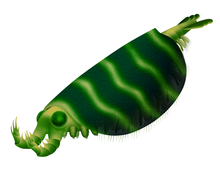Deuteropoda

| Deuteropoda | |
|---|---|
 | |
| Life restoration of Kylinxia zhangi, a basal deuteropod | |
 | |
| Life restoration of Surusicaris, a likely basal deuteropod | |
| Scientific classification | |
| Domain: | Eukaryota |
| Kingdom: | Animalia |
| Phylum: | Arthropoda |
| (unranked): | Deuteropoda Ortega-Hernández 2016[1] |
| Subphyla and classes | |
Deuteropoda is a proposed clade of arthropods whose members are distinguished from more basal stem-group arthropods like radiodonts by an anatomical reorganization of the head region, namely the appearance of a differentiated first appendage pair (the 'deutocerebral' pair), a multisegmented head, a hypostome/labrum complex, and by bearing pairs of segmented biramous limbs.[1]
The clade contains all living arthropods (i.e. chelicerates and mandibulates) as well as several fossil groups that share these characteristics (e.g. Fuxianhuiida Megacheira, Isoxyida, and Artiopoda), while excluding other fossil groups that are more 'basal' or 'primitive' (e.g. radiodonts, opabiniids and lobopodians).[1][3] Members of Deuteropda that are basal to the last common ancestor of chelicerates and mandibulates (and thus lie outside the crown group of Arthropoda) are often referred to as "upper stem group arthropods".[1]
Defining characteristics
[edit]Members of Deuteropoda are characterized by the presence of a differentiated labrum and a differentiated first 'deutocerebral' pair of appendages.[1] In contrast, lobopodians (part of the "lower stem group") and onychophorans have a pair of pre-ocular or 'protocerebral' appendages, which presumably have evolved to be the labrum of modern living arthropods.[3]
Phylogeny
[edit]The cladogram below is a possible panarthropod phylogeny, taking into account the differentiation between "lower stem group arthropods" and "upper stem group arthropods", based on cladograms found in Zeng et al. 2020 and O'Flynn at al. 2022.[4][5] (living groups are marked in bold). Not all parts of this cladogram are widely accepted, as some studies have found Isoxyida, Megacheira, Fuxianhuiida, and/or Artiopoda to lie outside of crown group Arthropoda,[6][7] while some other studies have found a closer relationship to Chelicerata than to Mandibulata for Artiopoda.[7]
| Panarthropoda | "lower stem group" "upper stem group" + crown group | |
References
[edit]- ^ a b c d e Ortega-Hernández, Javier (2016), "Making sense of 'lower' and 'upper' stem-group Euarthropoda, with comments on the strict use of the name Arthropoda von Siebold, 1848", Biol. Rev., 91 (1): 255–273, doi:10.1111/brv.12168, PMID 25528950, S2CID 7751936
- ^ McCall, Christian (13 December 2023). "A large pelagic lobopodian from the Cambrian Pioche Shale of Nevada". Journal of Paleontology. doi:10.1017/jpa.2023.63. Retrieved 13 December 2023.
- ^ a b Budd, Graham E. (2021). "The origin and evolution of the euarthropod labrum". Arthropod Structure & Development. 62: 101048. doi:10.1016/j.asd.2021.101048. ISSN 1467-8039. PMID 33862532.
- ^ Zeng, Han; Zhao, Fangchen; Niu, Kecheng; Zhu, Maoyan; Huang, Diying (November 2020), "An early Cambrian euarthropod with radiodont-like raptorial appendages", Nature, 588 (7836): 101–105, Bibcode:2020Natur.588..101Z, doi:10.1038/s41586-020-2883-7, PMID 33149303, S2CID 226248177
- ^ O’Flynn, Robert; Williams, Mark; Yu, Mengxiao; Harvey, Thomas; Liu, Yu (2022), "A new euarthropod with large frontal appendages from the early Cambrian Chengjiang biota", Palaeontologia Electronica, 25 (1): a6, doi:10.26879/1167, S2CID 246779634
- ^ Zhang, Caixia; Liu, Yu; Ortega-Hernández, Javier; Wolfe, Joanna M.; Jin, Changfei; Mai, Huijuan; Hou, Xianguang; Guo, Jin; Zhai, Dayou (2023-04-26). "Three-dimensional morphology of the biramous appendages in Isoxys from the early Cambrian of South China, and its implications for early euarthropod evolution". Proceedings of the Royal Society B: Biological Sciences. 290 (1997). doi:10.1098/rspb.2023.0335. ISSN 0962-8452. PMC 10113025. PMID 37072042.
- ^ a b Aria, Cédric (October 2022). "The origin and early evolution of arthropods". Biological Reviews. 97 (5): 1786–1809. doi:10.1111/brv.12864. ISSN 1464-7931. PMID 35475316. S2CID 243269510.





